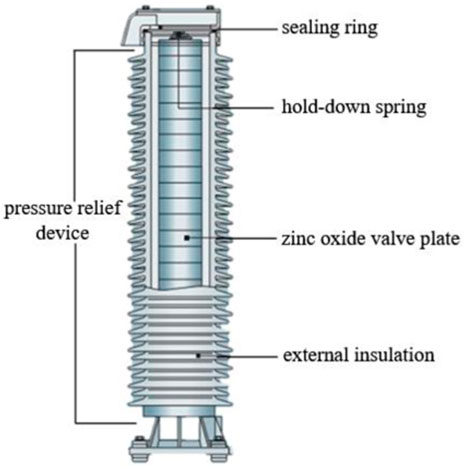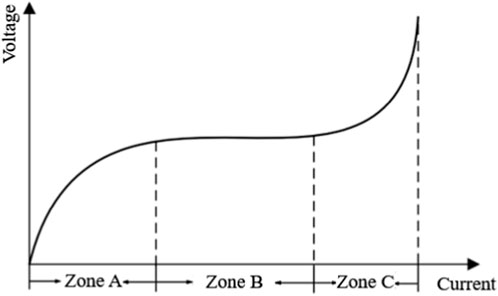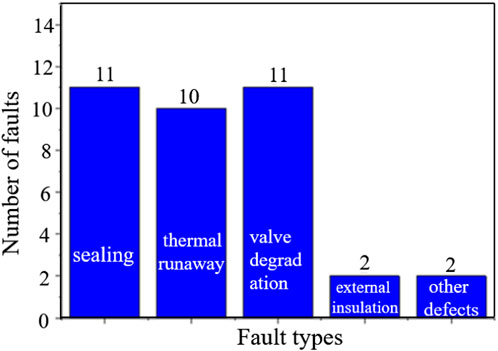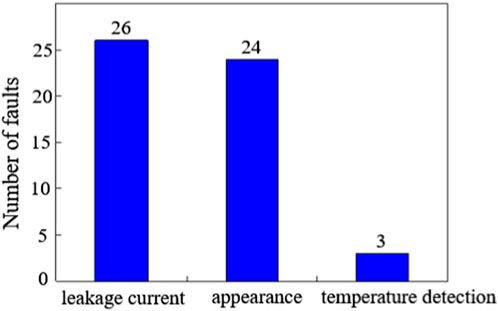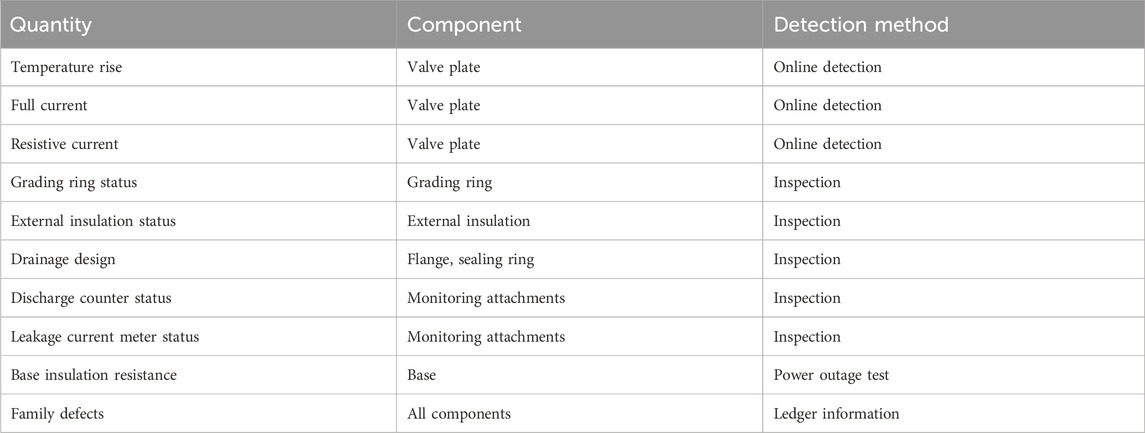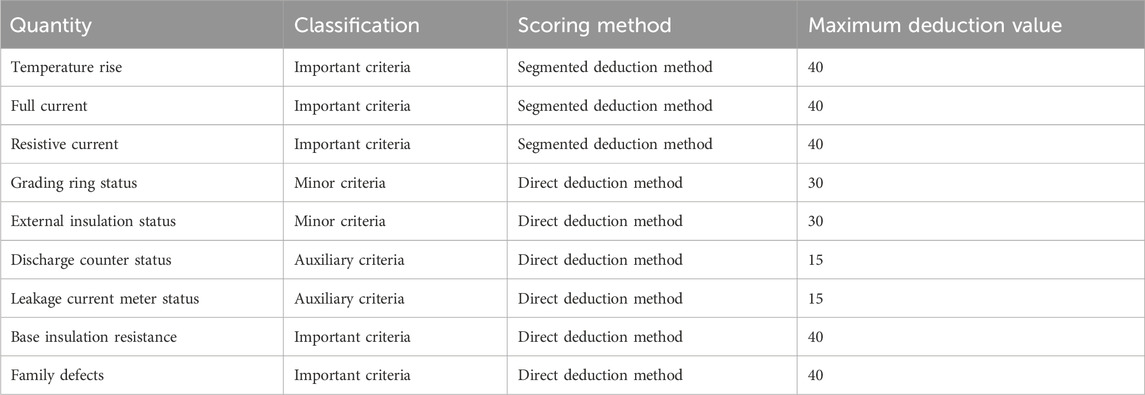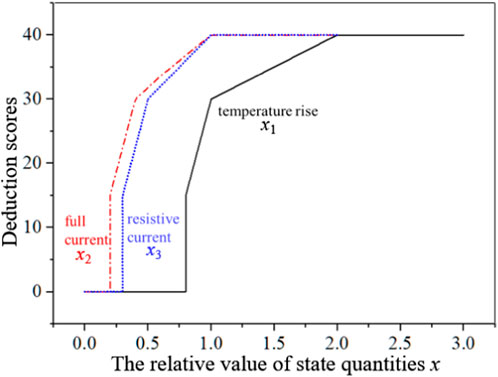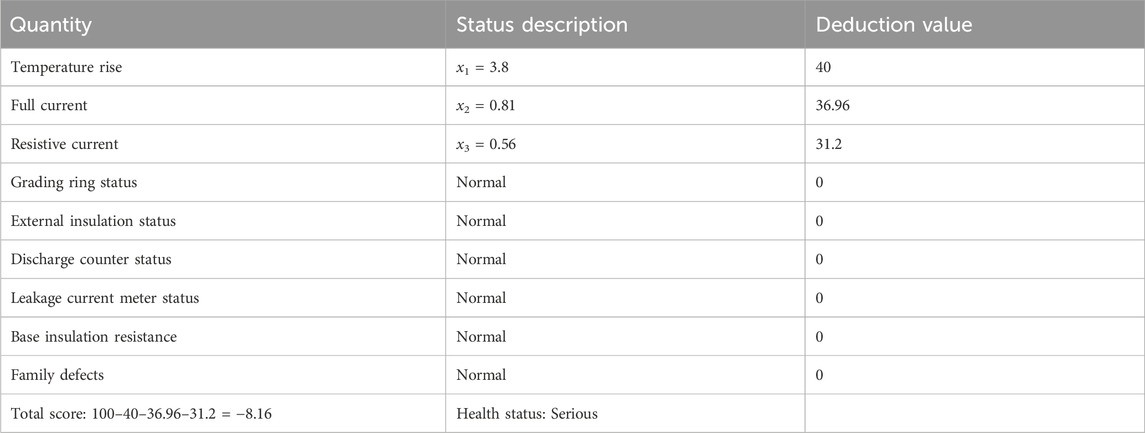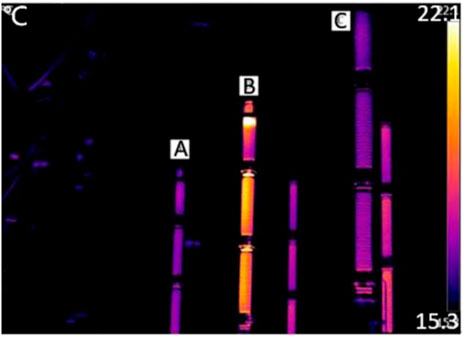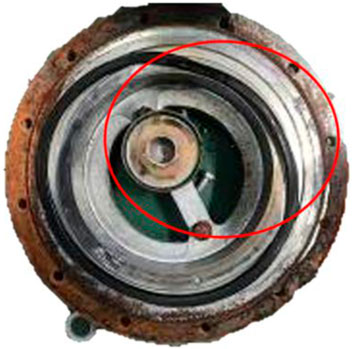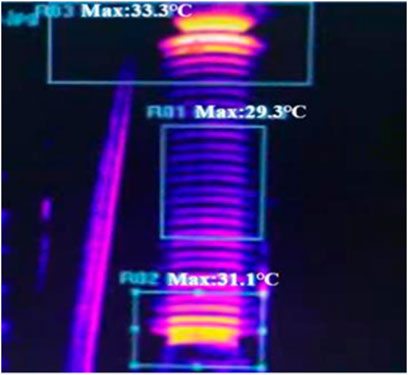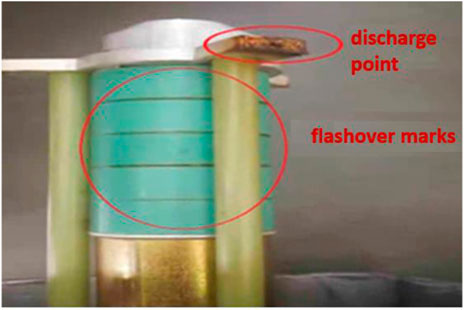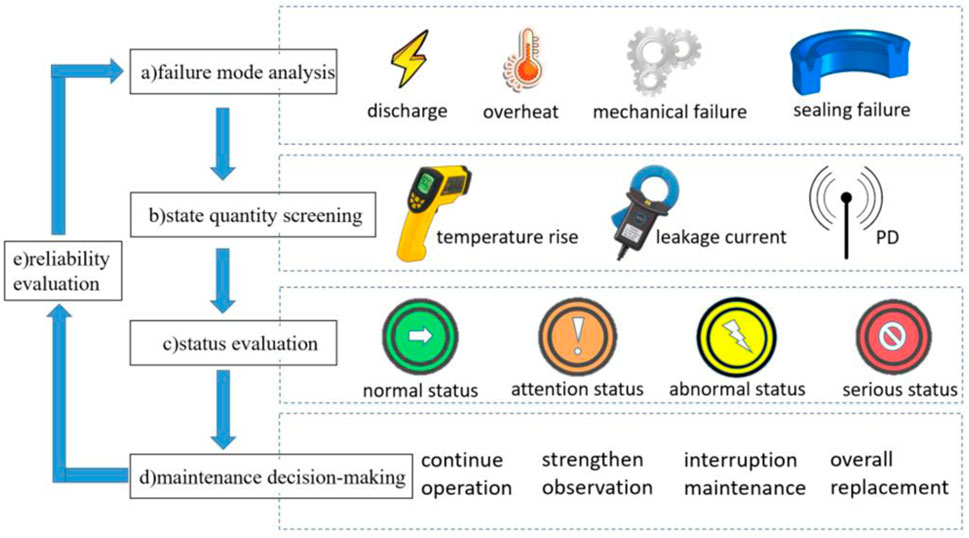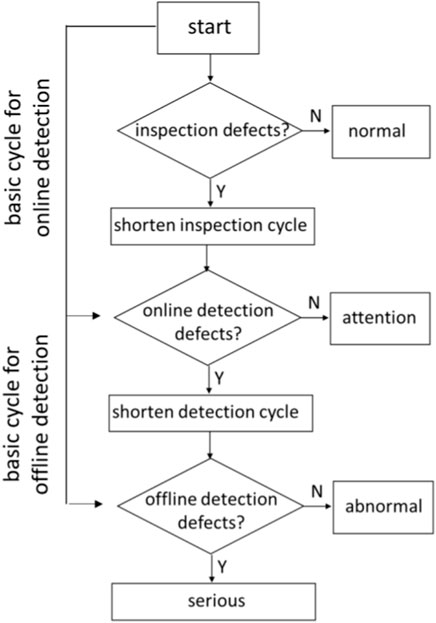- 1State Grid Zhejiang Electric Power Co., Ltd., Hangzhou, China
- 2Electric Power Research Institute of State Grid Zhejiang Electric Power Co., Ltd., Hangzhou, China
- 3School of Electrical Engineering and Automation, Wuhan University, Wuhan, China
Introduction: The reliability of power equipment is the foundation for maintaining the reliability of the power grid. As a core device for limiting overvoltage in the power grid, lightning arresters have received widespread attention, and ensuring their reliability is crucial.
Methods: To improve the reliability of zinc oxide surge arresters in the power system, the fault characteristics and health assessment methods of zinc oxide surge arresters were studied using reliability centered condition-based maintenance(RCCM). Firstly, the fault characteristic of zinc oxide lightning arresters in operation over years were collected and analyzed from different aspects. Then the effective state quantities corresponding to different types of defects and their detection methods were proposed. The health status evaluation model for zinc oxide lightning arrester was established, and the effectiveness of the evaluation model was verified through fault cases.
Results and Discussion: It shows that the proposed state quantities and RCCM method are suitable for the actual operation and maintenance of zinc oxide lightning arresters. It can reduce the workload and improve the efficiency of existing operation and maintenance of lightning arresters.
1 Introduction
Zinc oxide has advantages such as corrosion resistance, high temperature resistance, and less impact on the external circuit (Tsuboi et al., 2015). The above advantages make zinc oxide lightning arrester very suitable for limiting overvoltage induced by lightning or switching circuit. The zinc oxide arrester has advantages such as superior nonlinear characteristics and instant response (Jonathan, 2023). It is mainly used to limit overvoltage in power systems and is key equipment to ensure the safety of main equipment in power grid (Wanting, 2020; Shanqiang et al., 2018; Jianguo et al., 2022) or offshore wind turbines, etc., (Chen et al., 2022). Improving the reliability of zinc oxide lightning arrester itself is of great significance. However, the problem is how to accurately evaluate the health status of zinc oxide lightning arresters and carry out differentiated operation and maintenance, especially when equipment scale continues to expand but the maintenance resources remain relatively unchanged (Wei et al., 2019; Yan et al., 2023).
Present studies on zinc oxide lightning arresters are mainly focused on the characteristics of faults and their evolution patterns, status monitoring, and test techniques (Sabiha et al., 2020; Bingqian et al., 2021; Tianyong et al., 2014). Ruiqing et al. analyzed the detection process of an internal moisture defect of lightning arrester in the main transformer side, and proposed the specialized infrared thermal imaging measurement work once a year to timely detect the moisture defect (Ruiqing et al., 2019). Mingfeng et al. conducted the state evaluation of 220 kV lightning arrester and proposed the key factors for the state evaluation of lightning arresters, including sealing failure, external insulation deterioration, the connection between the outer shell and the flange, and the state of leakage current meter (Mingfeng et al., 2020). The impact of arresters on the lightning protection performance of 220 kV transmission lines has also been analyzed and verified (Pengkang and Zhen, 2022). The research on detecting the aging problem of lightning arrester valve plates through uninterrupted power supply has been earlier (Meng et al., 2009; Lin et al., 2023). Using the infrared radiation generated by the heating of the lightning arrester valve plate for detection is an effective method (Yuanyuan et al., 2023; Lin et al., 2022). Another main method of live detection is through leakage current, but leakage current is usually affected by environmental temperature (Jian et al., 2020), so the recognition accuracy of this method needs to be further improved. In addition, the failure of lightning arresters due to multiple lightning strikes is another factor that threatens the reliability of lightning arresters (Haryono et al., 2011). It is difficult to evaluate the performance of lightning arresters under multiple lightning strikes using traditional detection methods (Jinqiang et al., 2017). At present, the relevant international standards for zinc oxide lightning arresters are relatively mature, which plays an important role in the design, testing, and maintenance of lightning arresters (IEEE, 2020; IEC, 2014; IEC, 2018). Considering the detection efficiency of key state quantities, the safety and economic benefits of maintenance work, it is ready for lightning arresters to use condition-based maintenance (CBM) strategy based on online detection method. Previous studies provide a reference for improving the reliability of lightning arresters. But there is little research involving the optimization of maintenance strategies for zinc oxide lightning arresters, which is crucial for improving the maintenance efficiency.
Regarding the studies on equipment maintenance strategies, scholars mainly focus on two aspects, namely, reliability centered maintenance (RCM) and condition-based maintenance (CBM) (Ruifa et al., 2019; Huijun et al., 2020). RCM has been widely used in military, nuclear power, railways, aerospace facilities and other fields (Yutao et al., 2016; Jianhong, 2013). It plays an important role in improving equipment reliability and economy. The advantage of RCM is mainly in the requirement analysis of equipment maintenance, but it is difficult to provide detailed strategies on specific maintenance work. CBM is the main method for conducting specific equipment maintenance by status monitoring or online detection. And decisions are made based on the evaluation results of equipment status (Jinyu et al., 2020). The reliability centered condition-based maintenance (RCCM) is the latest equipment maintenance strategy developed in recent years (Ying et al., 2010). It comprehensively considers failure modes and their impacts, and classifies the maintenance projects and cycles of equipment. Based on RCCM, the equipment status and importance are used as the basis for maintenance plans. RCCM combines RCM with CBM, which firstly analyzes the maintenance requirements, and then determines the states to be detected, and then carries out specific work through CBM. The adoption of RCCM can help to improve the reliability of equipment and becomes the focuses of modern equipment management theory (Yu and Datong, 2014). However, RCCM is still in the initial stage. Further research on specific equipment and its actual application is needed.
This study uses RCCM on the maintenance of zinc oxide lightning arresters. It is organized as follows. Firstly, fault mode analysis of zinc oxide lightning arresters is conducted. Key state quantities are screened. Then a health status evaluation model is proposed using the above quantities, and finally the evaluation model is verified through practical cases.
2 Typical faults of zinc oxide lightning arrester
The first step of RCCM is to analyze the fault characteristics of equipment and then propose maintenance requirements. Therefore, the structure and function of zinc oxide lightning arresters are introduced. According to different materials of the jackets, lightning arresters are mainly divided into porcelain jackets and silicone rubber composite jackets (Liushou et al., 2021). The main structure of the ceramic lightning arrester is shown in Figure 1. The core component is zinc oxide resistor, which has nonlinear U-I curve characteristics, as shown in Figure 2. When applied voltage is lower than operating voltage, the current is small, usually in μA ∼ mA level, and can be considered as open circuit. When applied voltage exceeds the operating voltage of lightning arrester, the current increases rapidly while the voltage is limited, which can be regarded as short circuit. As the current continues to increase and exceeds the heat dissipation limit of the zinc oxide valve plate, the voltage will further increase, resulting in thermal collapse, which needs to be avoided in practice (Jian et al., 2023). Through the characteristic of non-linear relationship between voltage and current, the zinc oxide lightning arrester protects equipment in parallel with it from overvoltage damage.
Other functional components of zinc oxide lightning arresters include voltage equalizing rings, drainage lines, sealing rings, base supports, monitoring devices, current connectors, etc. The functional components can generally be classified into four types, namely, electrical parts, sealing parts, anti-explosion parts, and mechanical parts. By collecting lightning arrester faults of 110 kV and above in a certain province of China in the past 10 years, fault characteristics are analyzed from multiple dimensions such as operating years, fault types, and detection methods. Figure 3 shows the distribution of the faults over operating years. It can be seen that faults with a service life of less than 15 years account for a relatively high proportion, reaching 80%. The main causes of these faults are structural design, manufacturing or installation quality, and abnormal working conditions. Only 20% of faults have been in operation for more than 15 years, and the main cause of these faults is aging of the resistor or corrosion caused by long-term moisture exposure.
Figure 4 shows the fault types of lightning arresters, which can mainly be divided into sealing failure, thermal collapse, valve (i.e., resistor) degradation, external insulation, and mechanical defects. In the above faults, there is a strong correlation between sealing failure and valve degradation. Sealing failure usually leads to valve degradation, ultimately resulting in lightning arresters’ failure. The problem of thermal collapse is mainly caused by continuous lightning strikes in a short period of time, resulting in delayed heat dissipation. On the basis of mastering the fault types, we can take more targeted maintenance strategis.
The detection methods of lightning arresters’ faults are mainly divided into three categories, namely, daily inspections, online monitoring, and routine tests. The proportion of faults found by daily inspections is about 48.2%, about 40.9% by routine tests, and the proportion of direct faults is about 10.9%. Due to its significant environmental impact, online monitoring is currently less commonly used in practice, and therefore, defects are rarely detected through online monitoring. Direct faults usually refer to the detection of lightning arrester faults only after power outage, which will reduce the reliability of the power grid and should be avoided with utmost effort. The inspection project mainly includes leakage current meter data, infrared temperature measurement, and components’ appearance. Routine tests are mainly conducted through reference voltage at DC 1 mA, namely, U1mA, or leakage current at 0.75U1mA, or insulation resistance. In order to improve equipment utilization, online detection technology is required to gradually replace power outage testing. The distribution of lightning arresters’ faults discovered through inspection projects is shown in Figure 5. It can be seen that leakage current measurement and appearance inspection are much more effective. In addition, some faults are found through infrared temperature measurement. Temperature rise measurement and leakage current measurement usually have good correspondence for detecting moisture defects in lightning arresters. Based on the analysis of fault characteristics of lightning arresters, state quantities with better detection effect can be screened and used to evaluate the status of lightning arresters.
3 Health assessment of zinc oxide lightning arrester
3.1 Characteristic status quantities
The current state quantities of lightning arresters are shown in Table 1. It also provides the involved components and detection methods corresponding to the state quantities (National Energy Administration of China, 2021). Based on the analysis of existing fault cases, temperature rise measurement and leakage current online detection can effectively detect valve plate’s moisture or deterioration. And they are strongly correlated with U1mA and leakage current at 0.75U1mA. Therefore, online detection state quantities such as temperature rise, full current, and resistive current can be used as substitutes of U1mA and leakage current at 0.75U1mA. The optimized state quantities of lightning arresters are shown in Table 2.
The health evaluation was conducted using state quantities obtained by daily inspections, online detection, power outage tests, and ledger information in Table 2. The specific process of the evaluation is summarized as follows: 1) Different types of detection methods are carried out step by step, through daily inspections, online detection, and power outage tests; 2) Daily inspections are relatively frequently carried out, with heavy workload and low evaluation accuracy. Therefore, rough evaluations are made through daily inspections to only distinguish whether the equipment is normal or not. 3) For daily inspection and evaluation results that indicate attention or abnormal, online testing will be arranged to further evaluate whether it is attention, abnormal or serious; 4) Severe conditions are mainly detected through online detection or power outage tests; 5) Normal, attentive, abnormal, severe, and familial defects are all recorded in the ledger information and used as inputs for subsequent equipment health status evaluations.
3.2 Evaluation method and model
In the evaluation process, the status under different maintenance methods is carried out by scoring method. By relying on operational experience data and the importance of equipment functions corresponding to state quantities, different scores are assigned to each state variable, and a deduction function is used. This article divides state quantities into three categories: important, minor, and auxiliary. The status determined by scoring is shown in Table 3. The deduction function for important state quantities is set as a piecewise function, and for minor and auxiliary state quantities it is set as a single function.
The optimized state quantities and their scoring criteria are shown in Table 4. The important quantities mainly involve temperature rise and leakage current, which have good detection effects on lightning arrester moisture and valve degradation. The minor state quantities include the equalizing ring state, external insulation state, drainage design, etc., which do not affect the normal operation of the lightning arrester in the short term but has hidden dangers. The auxiliary state quantities include discharge counters, leakage current meters, etc., which are mainly accessories such as lightning arrester monitoring devices and have a relatively small impact on the lightning arrester.
To eliminate the influence of dimensional differences between state quantities on the evaluation, the change in the deviation value of state quantities relative to the initial value is used as a deduction reference. The important state quantities are explained as follows.
3.2.1 Temperature rise
The maximum allowable temperature rise and phase to phase temperature difference of zinc oxide lightning arresters with different voltage levels are different. This is determined by the heat dissipation performance of its zinc oxide valve plate. For example, the 500 kV lightning arrester has an allowable temperature rise of 3.0 K and a phase to phase temperature difference of 1.2 K. But the 220 kV lightning arrester allows for a temperature rise of 1.5 K and a temperature difference of 0.6 K and the 110 kV lightning arrester allows for a temperature rise of 1.0 K and a temperature difference of 0.5 K. The ratio of the measured temperature rise with the maximum allowable temperature rise can be characterized as the independent variable x1. When x1 is below 0.8, the deduction score is zero. When x1 is above 0.8 but below 1.0, points will be deducted within the range of 15–30. When x1 is above 1.0 but below 2.0, points will be deducted within the range of 30–40. When it exceeds 2.0, a maximum deduction of 40 points will be made.
3.2.2 Full current
The ratio of the increment of the measured full current compared to the initial value can be characterized as the independent variable x2, i.e., (measured full current—initial full current)/initial full current. When x2 is less than 0.2, it is in a normal state. When x2 is higher than 0.2 but lower than 0.4, points will be deducted within the range of 15–30. When x2 is higher than 0.4 but lower than 1.0, points will be deducted within the range of 30–40. A maximum deduction of 40 points is allowed when the score exceeds 1.0.
3.2.3 Resistive current
The ratio between the increment of the measured resistive current compared to the initial value and the initial value is characterized as the independent variable x3, i.e., (measured resistive current—initial resistive current)/initial resistive current. When x3 is less than 0.3, it is in a normal state. When x3 is higher than 0.3 but lower than 0.5, points will be deducted within the range of 15–30. Deduction points within the range of 30–40 is made when x3 exceeds 0.5 but belows to 1.0. A maximum deduction of 40 points is allowed when x3 exceeds 1.0.
The deduction functions of the three state quantities mentioned above are represented graphically in Figure 6. It can be seen that there is a difference in the deduction function between temperature rise and leakage current. The reason is that the leakage current can directly reflect the valve state, while the temperature rise is a reflection of the valve state within a certain time range. Therefore, the deduction function based on temperature rise is relatively more relaxed compared to the leakage current. By using this deduction method to score, the evaluation results will be more refined than simply judging the status through thresholds, which helps to achieve more differentiated management of different lightning arresters.
Compared to important state quantities, the evaluation functions for minor and auxiliary state quantities should be relatively simplified. When a minor state quantity deteriorates, 30 points are deducted for each item, and when an auxiliary state quantity appears, 15 points are deducted for each item. The final score is obtained by subtracting the total deduction points by 100. If the total deduction points exceed 100, the score will be less than 0 and the status will be severe. The smaller the score, the more severe the status is.
Using the above evaluation method and taking a 110 kV lightning arrester fault as an example, the status evaluation result is shown in Table 5. Based on inspection and online detection data, the final −8.16 points is determined, therefore the health status of the lightning arrester is judged as “serious.”
4 Analysis and discussion
The evaluation method optimized by effective state quantities has been applied in practice and effectively discovered defects in lightning arresters. Typical relevant cases are as follows.
4.1 Case 1
During the inspection, it was found that the leakage current of phase B of the lightning arrester in a 500 kV substation increased abnormally, and its status was evaluated as abnormal. Continuing with live testing, it was found that there was a significant abnormality in the resistive current, as shown in Figure 7. The accurate temperature measurement showed severe local overheating in the upper section of phase B, and overall heating in the middle and lower sections. The evaluation result was serious. On the basis of this result, power outage test was arranged and the equipment was returned to the factory for disassembly. Before disassembly, insulation resistance, reference voltage U1mA, and leakage current under 0.75U1mA were measured. It was found that the test data seriously exceeded the standard. And it was found that the inner sealing ring of the main cover plate was not installed correctly in the groove. There were obvious indentations on the sealing ring, as shown in Figure 8. The overall sealing performance failed, resulting in water accumulation inside the lightning arrester.
4.2 Case 2
During an inspection, it was found that the top and bottom temperatures of the C-phase of a 110 kV lightning arrester were too high, with a temperature difference of 4°C compared to the middle part. It was evaluated as abnormal, as shown in Figure 9. Subsequently, through online detection of the leakage current, it was found that the full current was 0.7 mA, which exceeded the standard reference value of 0.3 mA by 1.4 times. The evaluation result was serious, so the lightning arrester was arranged for replacement. The insulation resistance, U1mA, and leakage current value at 75% U1mA were higher than the standard, further verifying the effectiveness of the evaluation results. After disassembly, the core body is found to tilt to one side, and there are discharge marks on the inner wall of the porcelain sleeve. There is obvious contamination on the outer surface of the upper part of the core body compared to the lower part, as shown in Figure 10.
Through the actual fault detection cases of lightning arresters mentioned above, it is shown that the evaluation method using the key state quantities proposed in this article is basically feasible. Based on the above research, we can summarize the process of RCCM maintenance strategy for power equipment, as shown in Figure 11. It mainly consists of five stages. One is to analyze the types of equipment failures, and if necessary, fault impact analysis should also be conducted. The second is to filter out effective state quantities for accurate state evaluation. Thirdly, establish a reasonable state evaluation model and conduct state evaluation. Fourthly, make maintenance decisions. The fifth step is to evaluate the reliability of the equipment after maintenance and provide feedback on the fault information to the first step for the next round of fault analysis. After several iterations of such analysis, the reliability of the equipment can be greatly improved.
As a supplement to the RCCM process in Figure 11, we propose specific steps for conducting a health status assessment of lightning arresters, as shown in Figure 12. The step diagram is a procedural presentation of the efficient maintenance strategy for lightning arresters in the case study session. It can be seen that the method of detecting defects in lightning arresters is gradually becoming more complex. Most defects can usually be detected through inspections and online detection, and the maintenance cost is relatively low, so these two items can be prioritized. However, a benchmark period should still be set for different testing items in order to discover defects as comprehensively as possible. If no defects are found in the online or offline detection strategy and during historical inspections, it can be evaluated as normal. Moreover, the benchmark period cycle can also be extended.
This study analyzes the faults characteristics of zinc oxide lightning arresters in operation. By analyzing the equivalence of different state quantities in detecting the same type of defect, a state quantity optimization strategy is proposed based on inspection and online detection. Based on the optimized state quantities, a health state evaluation model for lightning arresters is proposed, which helps to improve the operational efficiency of lightning arresters. Through the detection of typical defects in the actual maintenance of lightning arresters, it is shown that the evaluation method has certain advantages of simple process and easy implementation, providing reference for the effective maintenance of zinc oxide lightning arresters. Due to the current limitation of sample size, reliability evaluation cannot be conducted at present, which is a direction that needs to be further studied in the future.
5 Conclusion
The following conclusion can be drawn through this study:
1) The faults of zinc oxide lightning arresters are mainly concentrated in the electrical and sealing systems, with sealing failure, valve plate dampness, and thermal collapse as the main faults. These characteristics provide reference for screening effective state quantities and conducting health status evaluation for zinc oxide lightning arresters.
2) On the basis of existing state quantities, U1mA and the leakage current under 75%U1mA in power outage tests can be replaced with inspection or online detection state quantities, namely, temperature rise and leakage current. The same faults can be effectively detected through fewer detection workload using the optimized state quantities, which will be beneficial for improving the maintenance efficiency.
3) Based on optimized state quantities, a health status evaluation model for zinc oxide lightning arresters using the combination of segmented deduction method and single deduction method is proposed. The feasibility of this evaluation model is verified through actual operation and maintenance cases, thereby avoiding lightning arrester failures. Using the proposed evaluation method, it is possible to effectively detect overheating defects caused by sealing defect or discharge of lightning arrester valve plates of different voltage levels.
5) Based on our RCCM maintenance strategy practice for lightning arresters, we have summarized a set of RCCM maintenance processes for electrical equipment, including five key steps: fault characteristics analysis, state quantity optimization, status evaluation, maintenance decision-making, reliability evaluation and feedback (FSSMR, take the first letter of each step for short). Through the continuous iteration of FSSMR in the maintenance practice of ZnO arresters, the efficiency of equipment management can be ensured and improved. The use of this strategy for larger scale practical and analytical validation research will be necessary for the future work.
Data availability statement
The original contributions presented in the study are included in the article/Supplementary material, further inquiries can be directed to the corresponding author.
Author contributions
FY: Conceptualization, Writing–original draft, Writing–review and editing. RH: Data curation, Funding acquisition, Resources, Writing–original draft. YZ: Supervision, Validation, Writing–original draft. PJ: Resources, Writing–review and editing. WW: Investigation, Supervision, Writing–review and editing. XD: Project administration, Supervision, Writing–review and editing.
Funding
The author(s) declare that no financial support was received for the research, authorship, and/or publication of this article. This work is funded by State Grid Corporation of China with funding project No. 5211DS220002.
Acknowledgments
Thanks to State Grid Corporation of China for project funding (5211DS220002).
Conflict of interest
Author FY was employed by State Grid Zhejiang Electric Power Co., Ltd. Authors RH, PJ, and WW were employed by Electric Power Research Institute of State Grid Zhejiang Electric Power Co., Ltd.
The remaining authors declare that the research was conducted in the absence of any commercial or financial relationships that could be construed as a potential conflict of interest.
Publisher’s note
All claims expressed in this article are solely those of the authors and do not necessarily represent those of their affiliated organizations, or those of the publisher, the editors and the reviewers. Any product that may be evaluated in this article, or claim that may be made by its manufacturer, is not guaranteed or endorsed by the publisher.
References
Bingqian, Z., Richang, X., Yang, Y., Tongping, X., Hongpeng, G., Lei, C., et al. (2021). Analysis of physical characteristics of power transformer windings under inter-turn short circuit fault. High. Volt. Eng. 47 (6), 2177–2185. doi:10.13336/j.1003-6520.hve.20201178
Chen, C., Jiuguo, G., and Penghao, C. (2022). A novel energy absorption-based protection scheme for surge transients in large-scale wind farm system. Front. Energy Res. 10, 846714. doi:10.3389/fenrg.2022.846714
Haryono, T., Sirait, K. T., and Berahim, H. (2011). Effect of multiple lightning strikes on the performance of ZnO lightning arrester block. High. Volt. Eng. (11), 2763–2771. doi:10.13336/j.1003-6520.hve.2011.11.023
Huijun, S., Yongxiu, H., Wei, X., Yan, Z., Lisha, Y., et al. (2020). Effect of different operational maintenance and repair strategies on annual downtime of transformer. Electr. Power 53 (8), 91–99. doi:10.11930/j.issn.1004-9649.201912130
IEC (2014). Surge arresters - Part 4: metal-oxide surge arresters without gaps for a.c. systems. IEC 60099-4: 2014.
IEEE (2020). IEEE standard for metal-oxide surge arresters for AC power circuits (>1 kV)-Redline IEEE Std C62.11-2020, 1–235. (Revision of IEEE Std C62.11-2012.
Jian, L., Dajie, L., Yingqiang, G., Shiyu, Z., Wenjun, W., Shenghui, W., et al. (2023). Study on variations in moisture-affected fault characteristics of EMU lightning arrester. Electr. Drive Locomotives 1, 131–137. doi:10.13890/j.issn.1000-128X.2023.01.017
Jian, W., Zhiye, D., Jianming, Z., Zhiwei, M., and Yiming, X. (2020). Experimental study of the influence of air temperature on the state parameters of ZnO arrester. Eng. J. Wuhan Univ. 53 (5), 430–434. doi:10.14188/j.1671-8844.2020-05-008
Jianguo, W., Zhiling, X., Li, C., Fang, Y., Lu, D., Huang, H., et al. (2022). Overvoltage response at the terminal for impulse current injection to 10 kV distribution line. IEEE Trans. Power Deliv. 37 (5), 3722–3729. doi:10.1109/tpwrd.2021.3135490
Jianhong, H. (2013). Design and application of SRCM at Fangjiashan nuclear power plants. China Nucl. Power 6 (1), 74–78.
Jinqiang, H., Jiajun, L., Wenfeng, L., Wang, H., Liao, Y., and Li, S. (2017). Structure-dominated failure of surge arresters by successive impulses. IEEE Trans. Power Deliv. 32 (4), 1907–1914. doi:10.1109/tpwrd.2016.2597191
Jinyu, Z., Yuanhong, C., and Cui, T. (2020). Application of traditional maintenance mode and state maintenance mode in substation maintenance. Electr. Drive Autom. 42 (6), 49–51.
Jonathan, W. (2023). Lightning protection of distribution power systems: arrester development and application over the years. IEEE Power & Energy Mag. 21 (2), 51–60. doi:10.1109/mpe.2022.3230890
Lin, H., Lijun, Z., Jiawei, Y., Liu, C., Wang, D., Yuan, S., et al. (2023). An impulse aging assessment method for arrester under multiple strokes based on frequency domain dielectric spectroscopy. IEEE Trans. Power Deliv. 38 (4), 2933–2943. doi:10.1109/tpwrd.2023.3264974
Lin, H., Lijun, Z., Wei, C., Wei, R., Zhang, D., Wang, D., et al. (2022). Analysis of thermal effects for polymer-housed metal-oxide surge arrester under multiple strokes. IEEE Trans. Power Deliv. 37 (5), 3917–3927. doi:10.1109/tpwrd.2022.3141397
Liushou, L., Quan, S., Yunwei, L., Yuxin, W., Le, Y., et al. (2021). Discussion of the problems for surge arrester test according type to IEC 60099-4. Insulators Surge Arresters 3, 75–80. doi:10.16188/j.isa.1003-8337.2021.03.011
Meng, G., Xuekun, H., and Anpei, T. (2009). Diagnosising and analysising the aged flaw of MOA valve piece. High. Volt. Appar. 45 (3), 145–147. doi:10.13296/j.1001-1609.hva.2009.03.037
Mingfeng, D., Xingwen, Y., and Wenbing, X. (2020). Defect analysis of 220kV surge arrester. Qinghai Electr. Power 9 (3), 55–57. doi:10.15919/j.cnki.qhep.2020.03.012
National Energy Administration of China (2021). Preventive test code for electric power equipment. DL/T 596.
Pengkang, X., and Zhen, F. (2022). Lightning performance of unshielded 220 kV transmission lines equipped with metal oxide arresters. IEEE Trans. Electromagn. Compat. 64 (3), 795–804. doi:10.1109/temc.2021.3135980
Ruifa, C., Yuankai, W., and Di, J. (2019). Construction of reliability-centered maintenance idea of distribution network. Electr. Eng. 10, 77–78. doi:10.19768/j.cnki.dgjs.2019.10.033
Ruiqing, S., Dan, W., and Bin, L. (2019). Research on the pollution fault characteristic of porcelain insulator under the influence of harmonic voltage. Insulators Surge Arresters 5, 194–199. doi:10.16188/j.isa.1003-8337.2019.05.031
Sabiha, N., Mahmood, F., and Abd-Elhady, A. (2020). Failure risk assessment of surge arrester using paralleled spark gap. IEEE Access 8, 217098–217107. doi:10.1109/access.2020.3042117
Shanqiang, G., Shuai, W., Jian, W., Chen, J., and Li, T. (2018). Development and application of ±500 kV DC transmission line arrester in China power grid. IEEE Trans. Power Deliv. 33 (1), 209–217. doi:10.1109/tpwrd.2017.2652479
Tianyong, X., Shaoxian, T., Gang, M., Bo, Z., Rongchao, L., Yaping, Z., et al. (2014). On-line monitoring and evaluation of ehv composite insulators based on leakage currents and environmental conditions. Insulators Surge Arresters 1, 6–22. doi:10.16188/j.isa.1003-8337.2014.01.008
Tsuboi, T., Takami, J., Okabe, S., Kido, T., and Maekawa, T. (2015). Energy absorption capacity of a 500 kV surge arrester for direct and multiple lightning strokes. IEEE Trans. Dielectr. Electr. Insulation 22 (2), 916–924. doi:10.1109/tdei.2015.7076792
Wanting, W. (2020). Study on the influence of lightning overvoltage on wind-photovoltaic hybrid power generation system. Insulators Surge Arresters 5, 176–182. doi:10.16188/j.isa.1003-8337.2020.05.029
Wei, C., Shuai, W., Shanqiang, G., Xu, H., Chen, J., Wang, J., et al. (2019). Development and application of lightning flashover limited equipment for 220 kV AC transmission line. J. Eng. 2019 (16), 802–805. doi:10.1049/joe.2018.8357
Yan, W., Shilei, G., Xiaoli, M., Yan, W., et al. (2023). Classification of single-phase ground faults in distribution network based on multi-domain features and fusion algorithm. High. Volt. Eng. 49 (5), 2059–2067. doi:10.13336/j.1003-6520.hve.20221023
Ying, P., Ming, D., and Mingjian, Z. (2010). Current status of machine prognostics in condition-based maintenance: a review. Int. J. Adv. Manuf. Technol. 50 (1-4), 297–313. doi:10.1007/s00170-009-2482-0
Yu, P., and Datong, L. (2014). Data-driven prognostics and health management: a review of recent advances. Chin. J. entific Instrum. 35 (3), 481–495. doi:10.19650/j.cnki.cjsi.2014.03.001
Yuanyuan, Z., Na, H., Shengkang, Y., Wei, L., Hui, L., Zhikun, L., et al. (2023). Thermal characteristics analysis of defects of 220 kV zinc oxide lightning arrester. Eng. J. Wuhan Univ. 56 (5), 599–605. doi:10.14188/j.1671-8844.2023-05-011
Keywords: zinc oxide lightning arrester, fault characteristics, health status assessment, reliability, state quantity, reliability centered condition based maintenance
Citation: Yang F, Han R, Zheng Y, Jiang P, Wang W and Dong X (2024) Reliability centered condition-based maintenance of zinc oxide lightning arresters: concept, process and case study. Front. Energy Res. 12:1359849. doi: 10.3389/fenrg.2024.1359849
Received: 22 December 2023; Accepted: 13 February 2024;
Published: 26 February 2024.
Edited by:
George Tsekouras, University of West Attica, GreeceReviewed by:
Vassiliki T. Kontargyri, National Technical University of Athens, GreeceCornel Hatiegan, Babeș-Bolyai University, Romania
Ioannis Gonos, National Technical University of Athens, Greece
Copyright © 2024 Yang, Han, Zheng, Jiang, Wang and Dong. This is an open-access article distributed under the terms of the Creative Commons Attribution License (CC BY). The use, distribution or reproduction in other forums is permitted, provided the original author(s) and the copyright owner(s) are credited and that the original publication in this journal is cited, in accordance with accepted academic practice. No use, distribution or reproduction is permitted which does not comply with these terms.
*Correspondence: Yu Zheng, enl3aHVlZUB3aHUuZWR1LmNu
 Fan Yang1
Fan Yang1 Yu Zheng
Yu Zheng